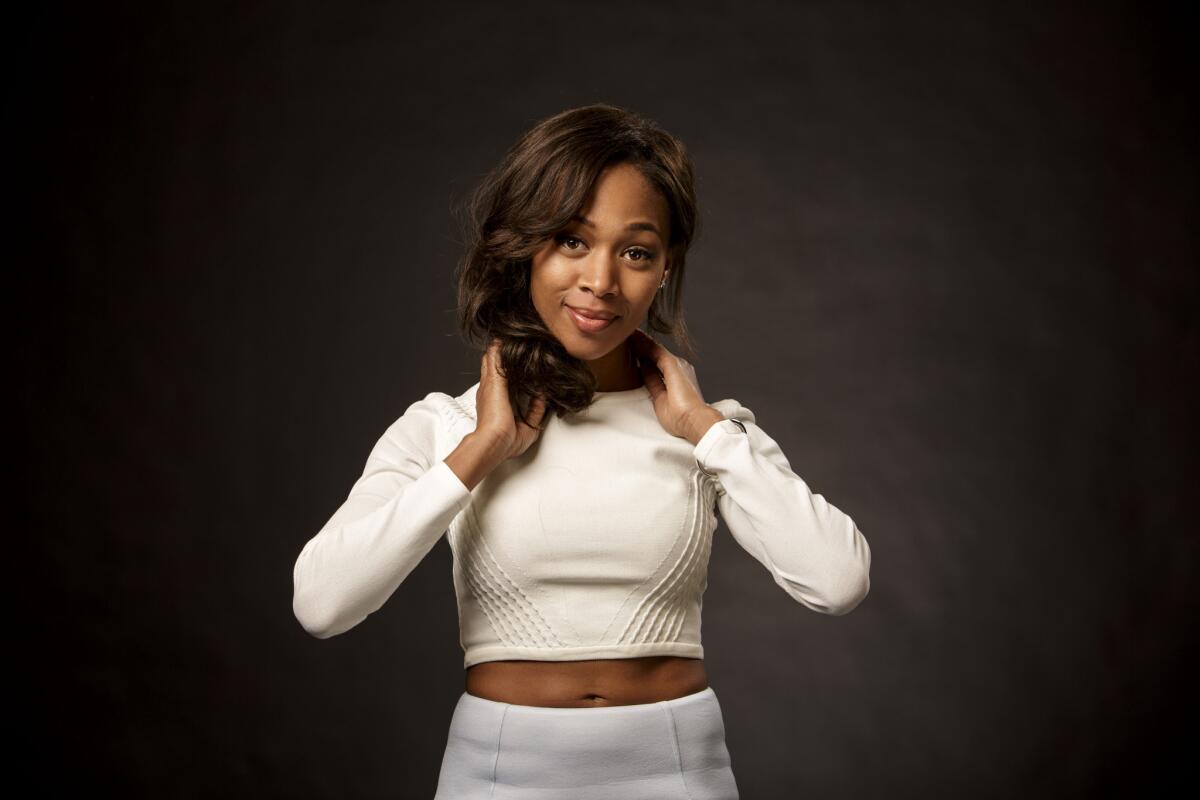Perspective: Yes, TV may seem to hold the higher ground on diversity. Until you notice whoâs doing all the dying

Actress Nicole Beharie, formerly of TV series âSleepy Hollowâ
Sometimes itâs good for a show to be at the unexpected intersection of two seemingly unrelated trends in television, to spark a conversation that uses narrative specifics to connect with some larger socio-political issue.
And sometimes itâs not.
The death of lead character Abbie Mills, played by Nicole Beharie, during the third-season finale of Foxâs supernatural drama âSleepy Hollowâ provoked howls of rage from fans, many of whom could not see the point in the show continuing without the female half of its central team (itâs not clear if the show will get a fourth season).
But it also gave a new and pointed focus to a larger issue or, rather, the collision of two larger issues: death and diversity.
Many feel that TVâs attempt to increase cast and character diversity is increasingly undercut by its equally new willingness to kill off popular characters.
Especially those who are not straight white males.
For years complaints about black men being used as zombie fodder have dogged âThe Walking Deadâ (which may or may not have just killed one of TVâs few Asian leads), while the recent deaths of LGBT characters on a wide range of shows seem to be resurrecting the Bury Your Gays and Dead Lesbian tropes. (Bury Your Tropes, Not Us is the new protest slogan.)
Long before this yearâs finale season, death came to a wide variety of non-straight-white-male characters, including several on the CWâs post-apocalyptic drama âThe 100â; early April saw the death of so many fictional women that some critics felt compelled to list them, like soldiers lost in a strange new war.
Not that the list was necessary. Fueled perhaps by the superior attitude the television industry took during the recent #OscarsSoWhite controversy â look at us, we have âEmpire,â âblack-ishâ and the oeuvre of Shonda Rhimes â fans have been steadily calling out the high fatality rate of minority characters for months now. (Including on âEmpire,â where a lesbian couple recently died in their attempt to kill Lucius.)
But when âSleepy Hollowâ killed Abbie, things got real.
For those who do not watch âSleepy Hollow,â which is to say the vast majority of Americans, her death may seem the very definition of a non-event.
A freshman hit, the show seemed to lose its way in Season 2, and by Season 3, despite a change in showrunner, it was in how-did-this-happen free-fall.
So itâs not terribly surprising that Beharie, who had previously drawn attention in the films â42â and âShame,â decided to leave, or even that the writers chose to explain that departure by death.

After all, why not? The finale, with its out-of-nowhere formation of a George Washington-sanctioned ghoul squad, was clearly a Hail Mary attempt at renewal, and certainly the American television audience is used to loss. Having survived Sean Beanâs beheading in âGame of Thrones,â Dan Stevens fleeing âDownton Abbyâ and Josh Charlesâ murder in âThe Good Wife,â we are a very different nation from the one that collectively collapsed on learning that Lt. Col. Henry Blakeâs plane had been shot down over the sea of Japan after McLean Stevenson decided heâd had enough of âMASH.â
Except.
Except Abbie was one of two lead characters in âSleepy Hollow,â and even in todayâs bloody clime, killing the lead is historically reserved for the dramatic final episode of a big hit (i.e. âBreaking Badâ). When the âBlacklistâsâ co-lead Elizabeth Keen (Megan Boone) died after giving birth during a recent episode, a narrative fake-out was immediately assumed, just as Stana Katicâs recent decision to leave âCastleâ appears to make a full ninth season impossible.
More important, Beharie was one of the few nonwhite female leads on television. Indeed, the Season 1 cast of âSleepy Hollow,â which included Lyndie Greenwood as Abbieâs sister, Jenny, and Orlando Jones as her commander, was praised by many (including me) for being a model for the industry.
And some believe that this was not just a case of a show failing and a star realizing she could do better elsewhere. Many âSleepyheadsâ felt that Abbieâs story had been systematically sidelined in favor of those that focused on her partner, Ichabod Crane (Tom Mison), which made Abbieâs decision to die in order to save him infuriatingly symbolic: the black female sacrificed to sustain another white-male-centric story line.
Itâs a legitimate reading of the show, though perhaps not the only one, but the fact of the analysis is far more important than its detail.
After years of obsessive and often-myopic deconstruction of certain series, the television audience is broadening its gaze to the bigger picture and realizing that the personal really is the political. The shows we watch are part of a larger presentation of modern life, and they matter both separately and as part of that whole.
Yes, there are more non-straight-white-male characters on television than ever before, and perhaps they seem equally represented in your favorite show, but overall white men continue to rule and everyone else exists mostly in the ensemble.
Which, in these days of death-at-anytime exposition and OMG pacing, makes them very vulnerable.
And while plenty of straight white guys get killed on television too, when one falls, another inevitably springs up to take his place. We miss Josh Charles, but would we trade Jeffrey Dean Morgan to get him back? Probably not. Because Willâs death on âThe Good Wife,â though upsetting, was not in any way political.
And thatâs whatâs changed. With televisionâs new status comes increasing responsibility; if youâre going to be at the vanguard of popular culture, then you need to, well, be at the vanguard of popular culture.
Itâs the stories that have to change, not just the window dressing. In life, women are not the minority, and when taken together, neither are people who are black, Asian, Latino, LGBT or any other definition that television still sees as ânontraditional.â These characters should not be used as seasoning or garland to give a white manâs story a little spice, a little color. They should be telling their stories too, in ways that donât call for the ultimate sacrifice quite so often.
Where, one wonders, are the âIf They Kill Michonne, We Riotâ T-shirts? Because I want one.
And writers need to be aware of this, or face the increasing and righteous wrath of those whose attentions they seek. Sure, social media was born to make mountains out of molehills, and no story should ever be formed by focus group or Twitter trend.
But viewers often see what the creators do not, and if networks and show runners are going to leverage the audience through social media for their own marketing ends, they had better get used to being leveraged right back.
An alarming trend has emerged in television, and whatever the intentions of each particular show, each group of writers, the end result is undeniable.
Oh, and Elizabeth Keen (âThe Blacklistâ) had better not be dead, and there really is no âCastleâ without Kate.
A previous version of this post identified the film â42â as â24.â
MORE:
After âGame of Thronesâ ends its epic run, how will HBO fill the void?
After #OscarsSoWhite, Academy clears the air about new membership rules
Tribeca Fest: âJunction 48â wrestles with race and violence amid Middle East rap scene
More to Read
The complete guide to home viewing
Get Screen Gab for everything about the TV shows and streaming movies everyoneâs talking about.
You may occasionally receive promotional content from the Los Angeles Times.







